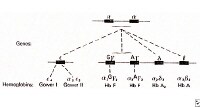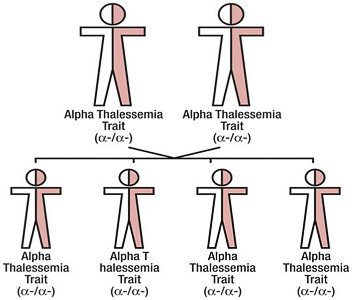Alpha-thalassemia (α-thalassemia, α-thalassaemia) is a form of thalassemia involving the genes HBA1 and HBA2. Alpha-thalassemia is due to impaired production of 1,2,3, or 4 alpha globin chains, leading to a relative excess of beta globin chains. The degree of impairment is based on which clinical phenotype is present (how many chains are affected).
Epidemiology

The worldwide distribution of inherited alpha-thalassemia corresponds to areas of malaria exposure, suggesting a protective role for alpha-thalassemia against the more severe manifestations of malaria. Thus, alpha-thalassemia is common in sub-Saharan Africa, the Mediterranean Basin, the Middle East, South Asia, and Southeast Asia, and different genetic subtypes have variable frequencies in each of these areas. The epidemiology of alpha-thalassemia in the US reflects this global distribution pattern. The most common form of alpha(+) thalassemia seen in the US is due to the -alpha(3.7) deletion, a single alpha-globin gene deletion, and is present in approximately 30% of African Americans. However, even in the homozygous state this disorder will result only in a mild microcytic anemia. The more serious clinical disorders of Hb H and Hb Bart hydrops fetalis syndrome, although found throughout the US today, are more common in the Western US and have dramatically increased in prevalence in the past 2 decades due to increased Asian immigration.
Causes

It is most commonly inherited in a Mendelian recessive fashion. It is also connected to the deletion of the 16p chromosome.
It can also be acquired, under rare circumstances. Due to the low occurrence of alpha-thalassemia, the disease can be mistaken for iron deficiency anemia.
Pathophysiology

α thalassemias result in decreased alpha-globin production, therefore fewer alpha-globin chains are produced, resulting in an excess of β chains in adults and excess γ chains in newborns. The excess β chains form unstable tetramers (called Hemoglobin H or HbH of 4 beta chains) which have abnormal oxygen dissociation curves. The excess γ chains form tetramers which are poor carriers of O2 since their affinity for O2 is too high so it is not dissociated in the periphery. Homozygote α0 thalassaemias, where there is lots of γ4 but no α-globins at all (referred to as Hb Barts), often result in still birth.
Types

There are two genetic loci for α globin, and thus four genes in diploid cells. Two genes are maternal in origin and two genes are paternal in origin. The severity of the α thalassemias is correlated with the number of affected α globin genes: the greater, the more severe will be the manifestations of the disease.
When noting the genotype, a "-" indicates an absence of function, and a "α" indications a functional alpha chain. (In contrast to the "βo" and "β+" notation used in beta-thalassemia, in alpha-thalassemia a distinction between absent and reduced function is not usually noted.)
References
